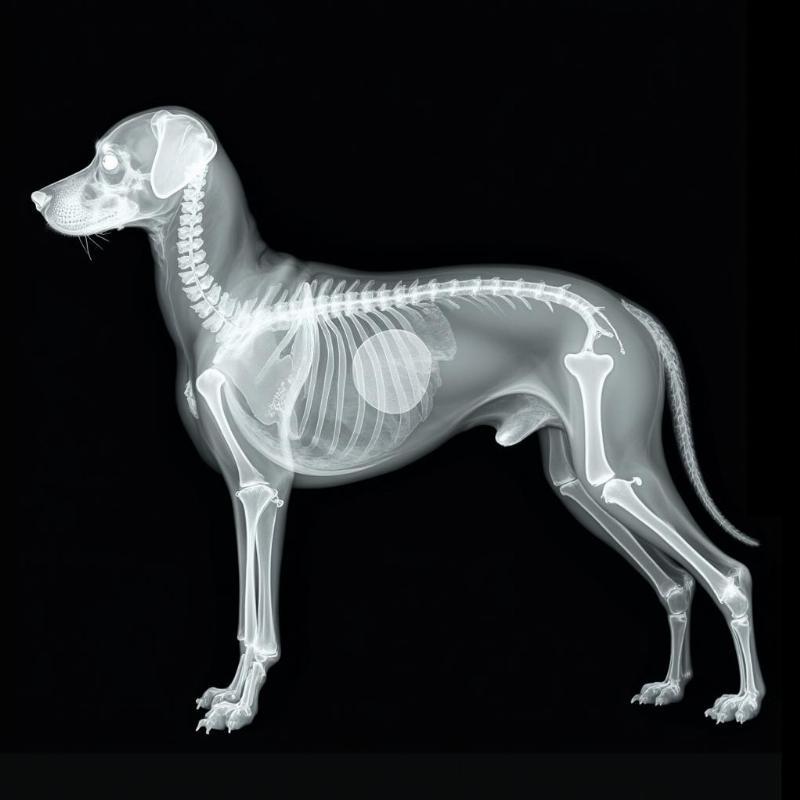A normal abdominal x-ray is a crucial diagnostic tool for veterinarians in the US, offering a window into your dog’s internal health. Understanding what constitutes a “normal” x-ray can help pet owners better grasp their dog’s health status and potential issues. This article will delve into the intricacies of normal abdominal x-rays in dogs, empowering you to communicate effectively with your vet and make informed decisions regarding your furry companion’s well-being.
Deciphering a Dog’s Abdominal X-Ray: What’s Normal?
A dog’s abdominal x-ray, also known as a radiograph, reveals a grayscale image of the organs within the abdomen. Veterinarians are trained to identify the size, shape, and position of these organs, looking for any deviations from the norm. A “normal” x-ray indicates that the organs appear as expected for the dog’s breed, age, and size. This doesn’t necessarily guarantee perfect health, but it suggests the absence of readily visible structural abnormalities.
 Normal Dog Abdominal X-Ray Example
Normal Dog Abdominal X-Ray Example
Factors like gas, ingested material, and the dog’s position during the x-ray can influence the image. Therefore, your veterinarian’s expertise is essential in interpreting these nuances and ensuring an accurate assessment.
Key Organs Visible on a Normal Abdominal X-Ray
Several key organs are scrutinized on a normal abdominal x-ray. These include the liver, stomach, spleen, intestines (small and large), kidneys, and bladder. Each organ has a characteristic appearance on the x-ray, allowing veterinarians to assess their size and position relative to each other.
The Importance of Size and Position
The size and position of each organ are critical factors in determining normalcy. For instance, an enlarged liver might suggest liver disease, while a displaced stomach could indicate a diaphragmatic hernia. The intestines should be uniformly distributed, without any signs of blockage or twisting. The kidneys should be symmetrical, and the bladder should be appropriately sized, depending on the dog’s recent urination habits.
Why Are Abdominal X-Rays Performed?
Abdominal x-rays are performed for a variety of reasons, including investigating vomiting, diarrhea, abdominal pain, suspected foreign body ingestion, trauma, and pre-surgical evaluations. They provide valuable information that can guide diagnosis and treatment decisions.
When is an Abdominal X-Ray Recommended?
“If your dog is exhibiting symptoms like persistent vomiting, loss of appetite, or changes in bowel habits, an abdominal x-ray can be a valuable diagnostic tool,” explains Dr. Emily Carter, DVM, a board-certified veterinary radiologist. “It allows us to visualize the internal organs and identify potential issues that may not be apparent through physical examination alone.”
Common Misconceptions About Abdominal X-Rays
Some pet owners believe that abdominal x-rays can diagnose every abdominal problem. However, while x-rays are excellent for visualizing bones and some soft tissues, they may not always reveal subtle changes or certain types of abnormalities. In such cases, additional imaging techniques like ultrasound or MRI might be necessary.
Conclusion
Understanding what a normal abdominal x-ray looks like in a dog is crucial for responsible pet ownership. While this article provides a general overview, it’s important to remember that interpreting x-rays requires professional veterinary expertise. By partnering with your veterinarian and understanding the information provided by diagnostic imaging, you can ensure your furry friend receives the best possible care.
FAQs
- How much does a dog abdominal x-ray cost in the US? The cost can vary depending on location and clinic, but typically ranges from $150 to $300.
- Is anesthesia required for an abdominal x-ray? Generally, no. Most dogs can be positioned for x-rays without anesthesia.
- How long does it take to get the results of an abdominal x-ray? Results are usually available within a short time, often on the same day.
- Can an abdominal x-ray detect cancer in dogs? X-rays can sometimes reveal masses or changes suggestive of cancer, but further tests are usually needed to confirm a diagnosis.
- What should I do if my dog’s abdominal x-ray is abnormal? Your veterinarian will discuss the findings with you and recommend the appropriate next steps, which might include further testing or treatment.
- Are there any risks associated with abdominal x-rays? The amount of radiation exposure is minimal and considered safe for dogs.
- How often should a dog have an abdominal x-ray? X-rays are not routinely performed unless there is a medical reason.
Related Articles
how long to keep dogs off weed and feed
Beautdogs.us is your premier online resource for comprehensive dog care, breed information, and product recommendations in the USA. We are committed to providing both novice and experienced dog owners with reliable, up-to-date information, empowering you to give your canine companion the best possible life. From understanding normal abdominal x-ray dog results to navigating the complexities of various breeds, Beautdogs.us is your trusted partner. Contact us today for more information: Email: [email protected], Phone: +1 501-555-7529.